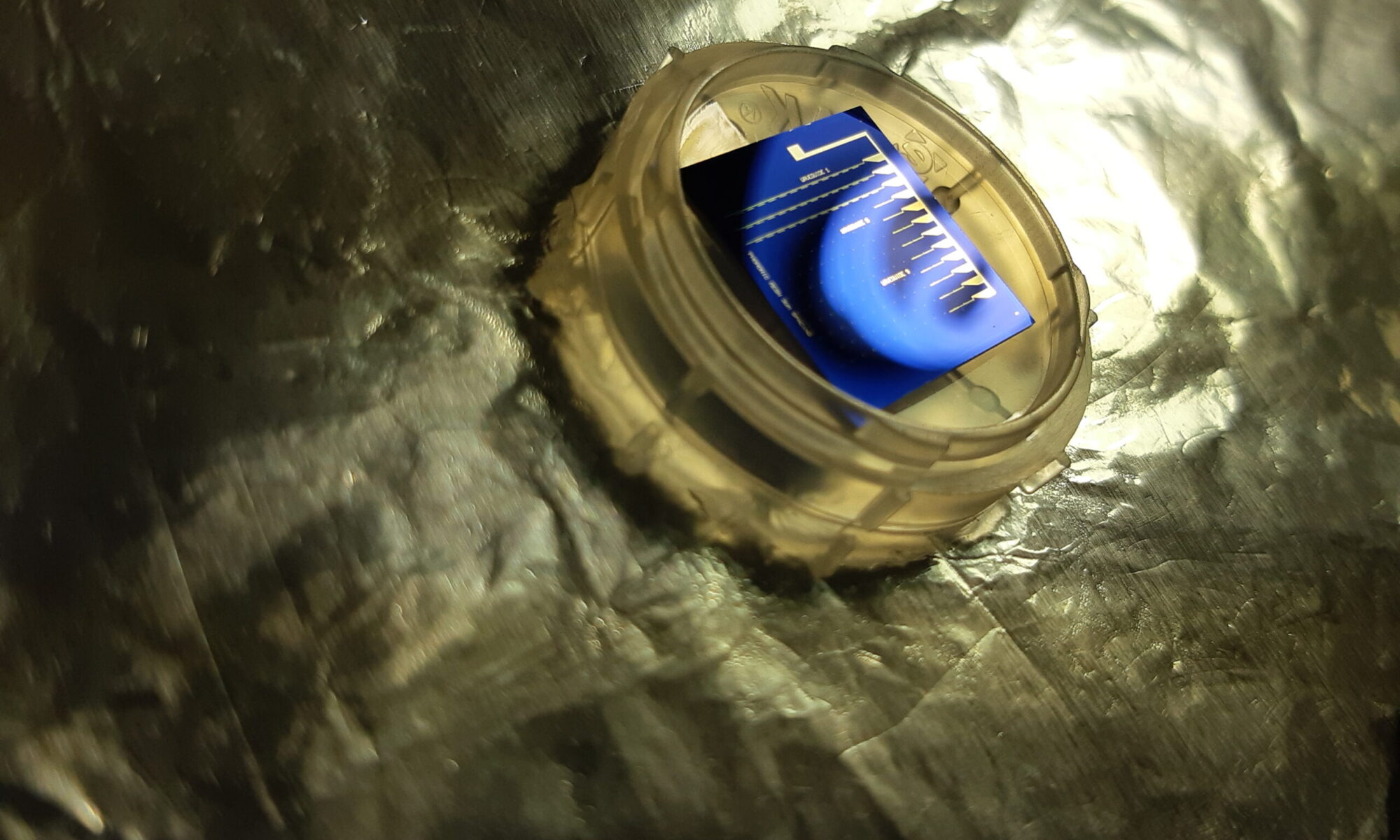
Interfaces are created between light and electronics, through their common interaction with a mechanical element.
Opto-electromechanical interfaces can be used to integrate quantum photonic systems with quantum superconducting circuits in future quantum information devices, for improved on-chip clocks and receivers for mobile communications that benefit from laser control and measurement, and for scalable photonic circuitry and photonic links in next generation computer chips, among other applications.
Recent work on this topic includes:
- “Free spectral range electrical tuning of a high quality on-chip microcavity,”
Opt. Express, vol. 26, pp. 33649–33670, Dec. 2018. (Skip to section) - “Injection locking of an electro-optomechanical device,”
Optica, vol. 4, pp. 1196-1204, Sept. 2017. (Skip to section) - “High bandwidth on-chip capacitive tuning of microtoroid resonators,”
Optics Express, vol. 24, p. 20400, Sept. 2016. (Skip to section) - Optically tunable on-chip photoluminescence and laser source
arXiv:2007.12472, (2020) (Skip to section)
High bandwidth on-chip capacitive tuning of microtoroid resonators

In this work, gold electrodes patterned onto the microtoroid resonator (see above) allow for rapid capacitive tuning of the optical whispering gallery mode resonances while maintaining their ultrahigh quality factor, enabling applications such as efficient radio to optical frequency conversion, optical routing and switching applications. A voltage bias applied between the electrodes leads to an attractive capacitive force, which radially strains the device, reducing its size and shifting its optical resonances (see right). This capacitive actuation approach presents several advantages. First it allows for very fast electrical tuning of the resonances reaching up to the tens of MHz range—several orders of magnitude faster than previously demonstrated schemes for microtoroids—while maintaining the ultra-high Q nature of the resonances. Moreover, capacitive tuning requires minimal power expenditure as there is no current flow between the electrodes in the steady state, unlike thermal tuning schemes.
Read more here:
- “High bandwidth on-chip capacitive tuning of microtoroid resonators,”
Optics Express, vol. 24, p. 20400, Sept. 2016.
Free spectral range tuning of a microresonator

Opt. Express, vol. 26, pp. 33649–33670, Dec. 2018.
The ability to tune a resonator by an optical linewidth enables optical modulation, as described above. A much more stringent criterion corresponds to the ability to tune a resonator by an entire free spectral range (FSR). FSR-tuning allows resonance with any source or emitter within the material’s transparency range, or between any number of networked microcavities (see animation below). This is typically hard to achieve in miniature resonators due to the very large strains (for strain tuning) or temperatures (for thermal tuning) required. We achieve this here through the use of a double-disk architecture which affords:
- Larger mechanical compliance for out-of-plane mechanical motion compared to the radial strain used in our previous work [Optics Express, vol. 24, p. 20400, 2016.] (i.e. easier to bend a ruler than compress it along its length),
- Higher capacitive force due to more interdigitated electrodes spaced closer together,
- Larger optomechanical coupling rate ∂ω/∂x enabled by the double-disk architecture.
With this approach, we demonstrate an on-chip high quality microcavity with high Q resonances that can be electrically tuned across a full free spectral range (FSR) -see video below- with low voltages and sub-nanowatt power consumption.


Read more here:
- “Free spectral range electrical tuning of a high quality on-chip microcavity,”
Opt. Express, vol. 26, pp. 33649–33670, Dec. 2018. [pdf] - here
Injection-locking of optomechanical resonators


The same electrodes used for tuning of the WGM resonator’s optical resonances (see above), can be used to injection-lock the device’s mechanical resonances, i.e. provide the spontaneous locking of the mechanical vibrations to an external drive tone provided by the integrated electrodes.
(This technique is often used in the optical domain in order for a high-power, noisy laser to acquire the spectral characteristics of a low-power, low-noise seed laser, read more here).
We employ this technique to suppress the drift in the optomechanical oscillation frequency, strongly reducing phase noise by over 55 dBc/Hz at 2 Hz offset and tune the oscillation frequency by more than 2 million times its narrowed linewidth, enough to overcome fabrication-induced mechanical frequency variability. We also show how our approach may enable control of the optomechanical gain competition between different mechanical modes of a single resonator.
Read more here:
- “Injection locking of an electro-optomechanical device,”
Optica, vol. 4, pp. 1196-1204, Sept. 2017.
Optically tunable photoluminescence and upconversion lasing on a chip

The ability to tune the wavelength of light emission on a silicon chip is important for scalable photonic networks, distributed photonic sensor networks and next generation computer architectures. Here we demonstrate light emission in a chip-scale optomechanical device, with wide tunablity provided by a combination of radiation pressure and photothermal effects.

To achieve this, we develop an optically active double-disk optomechanical system through implantation of erbium ions. We observe frequency tuning of photoluminescence in the telecommunications band with a wavelength range of 520 pm, green upconversion lasing with a threshold of 340±70 μW, and optomechanical self-pulsing caused by the interplay of radiation pressure and thermal effects. These results provide a path towards widely-tunable micron-scale lasers for photonic networks.
Read more here:
- C. J. Bekker, C. G. Baker, and W. P. Bowen, Radiation Pressure-Tunable Photoluminescence and Upconversion Lasing on a Chip, arXiv:2007.12472, (2020).
- see also: “Free spectral range electrical tuning of a high quality on-chip microcavity,”Opt. Express, vol. 26, pp. 33649–33670, Dec. 2018. [pdf]
Links:
See also: PhD thesis by Christiaan Bekker (2020)
We gratefully acknowledge funding from:




